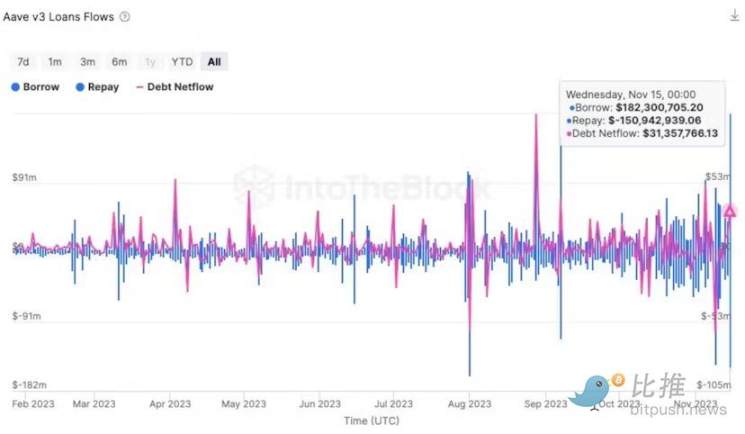Aave v3 loan volume soars to record levels, is DeFi making a comeback?
Written by: BitpushNews
Decentralized Finance (DeFi) is shaking off its lethargy.
According to data from DeFiLlama, DEXs have experienced their best week since March in terms of trading volume, with the total value locked (TVL) reaching its highest level since June. The overall TVL of DeFi has risen from $35.883 billion on October 12 to the current $46.236 billion, an increase of $10.353 billion.
In the past 30 days, the TVL of the top ten DeFi platforms has grown by over 15%, with six protocols seeing growth exceeding 25%.
Data from IntoTheBlock shows that Aave v3 has set a new daily borrowing record.
The increase in traders' risk appetite is driving DeFi activity, fueled by speculation that a spot Bitcoin ETF will be approved in January next year and a more favorable (or at least less pessimistic) macro environment. IntoTheBlock analyst Lucas Outumuro stated in a research report: "As people rush to speculate, the demand for leverage has been increasing."
Aave Sets Record Borrowing Volume
Data from IntoTheBlock shows that on November 15, Aave v3 on Ethereum borrowed a record $182 million in assets. The repayment amount for that day was $150 million, with a net inflow of $31 million. Nevertheless, the overall trend indicates a continued increase in demand for loans.

Higher Yields and TVL
The demand for borrowing is pushing up yields. This week, the borrowing rate for USDC on Aave climbed to 9.2%, while the borrowing rate for the protocol reached 7.6%, both the highest levels since August.

Higher yields are attracting more liquidity, thereby increasing TVL. According to data from DeFiLlama, assets deposited in smart contracts have been experiencing slight growth since last month, surpassing $47 billion for the first time since May.
DeFi trading activity is also on the rise. According to DeFiLlama, last week, DEX trading volume reached $244 billion, the highest level since the week of March 18. October was the best month for DEXs since June, with a trading volume of $61.4 billion.

Strong Performance of DeFi Tokens
As traders ramp up their risk bets, the prices of DeFi tokens are climbing. Data from Coingecko shows that the market capitalization of the DeFi sector is $65 billion, the highest level since May.
Additionally, among the top 10 performing tokens in the past day, five are DeFi protocols, including dYdX (ethDYDX), PancakeSwap (CAKE), Joe (JOE), THORChain (RUNE), and Lido DAO.

Looking at the 7-day chart, four of the top ten performing tokens are also DeFi tokens, with 0x Protocol (ZRX) and Yearn.finance (YFI) joining dYdX (ethDYDX) and THORChain (RUNE) as DeFi tokens with double-digit returns.
Funding pools for DeFi developers have also expanded. As previously reported by Bitpush, Arbitrum plans to allocate approximately $44 million from its treasury to provide short-term incentives for various projects, hoping they will contribute to the network's development. The second proposal will pay an additional $25 million in grants at current market prices, which is set to pass soon. Polygon also announced its own $78 million funding plan last week.
A Surface-Level Bull Market?
In response to the recent optimism, some community users are cheering, saying, "The bull is back, hurry back," but Bankless co-founder David Hoffman believes that if this is a bull market, it is very different from previous ones.
Hoffman stated in his article that people are bullish due to the imminent launch of spot ETFs. The approval of a spot Bitcoin ETF could happen at any time, and a spot Ethereum ETF is also on the horizon. This is a moment the industry has been waiting for over a decade; if the approval of these spot ETFs triggers a bull market, it would be the first time the crypto industry experiences a bull market driven by external stimuli, but lacking endogenous catalysts.
Hoffman argues that, first, there are no new reasons for people to enter the crypto space in a native way; the industry has not unlocked any new primitives. Retail investors do not care whether Polygon or Solana has lower-cost block space and improved execution environments. Secondly, no new applications have been built.
The rise in asset prices is in itself a form of marketing; the reopening of casinos and people making money for the first time in two years are the driving forces for re-entering the market. Hoffman warns that without some new applications or primitives for people to use, like in 2013, 2017, and 2021, this rebound will be short-lived, and a true bull market requires an endogenous catalyst.











